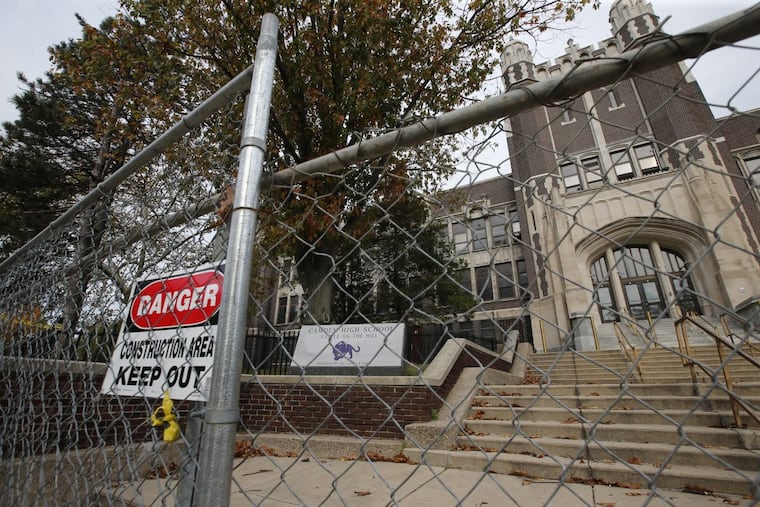With excavators ready, state board won't consider historic-site status for Camden High School
The school, built in 1916, was designed by influential Philadelphia architect Paul Armon Davis III.

The clock is ticking for Camden High School alumni who hope to save their alma mater from the state's demolition plans. And in recent days, their chances have dwindled further.
A proposal to designate the building a historic site was dropped on Oct. 27 from the agenda for the Nov. 9 meeting of the State Review Board for Historic Sites. Those who compiled research for the 47-page application were notified by the Historic Preservation Office the same day.
"It was disappointing. Everyone in the city loves the school. Nobody wants to see it go," said Doris Carpenter, the 1981 Camden High School graduate who prepared the application on behalf of the Camden High School PTO and Camden County NAACP, among other groups.
For those who hoped to stall the plan, the effort to gain historic designation for the building was one of the most promising avenues to rescue what is nicknamed by residents "The Castle on the Hill." The school, built in 1916, was designed by influential Philadelphia architect Paul Armon Davis III.
If added to the state's register of historic places, Camden County High School would be eligible for grants and low-interest loans for rehabilitation, according to the Historic Preservation Office website. Public plans that would "encroach upon, damage, or destroy" a designated building would be reviewed by the Historic Sites Council and the DEP commissioner.
In January, the school was put on the register through a "certificate of eligibility," but that classification does not protect the building from demolition, a state spokesperson previously told the Inquirer and Daily News.
A spokeswoman for the Department of Environmental Protection said Tuesday the nomination to designate the building as a historic site is no longer being considered because a contract to demolish the school was executed in September. The Schools Development Authority issued a $6.6 million contract to Philadelphia construction company USA Environmental Management Inc. on Sept. 1.
Caryn Shinske declined to comment on why there was a two-month gap between when the demolition contract was awarded and the nomination was taken off the board's agenda.
She would say only that "the nomination was removed from the agenda because a contract was executed."
Asked whether it is standard procedure to remove a proposal once a contract is awarded, Shinske pointed to the142-page New Jersey Register of Historic Places Act.
The school's historic significance lies in its early 20th-century Collegiate Gothic Style architecture — a design that mimicked Oxford and Cambridge. In 2017, preservation advocacy group Preservation New Jersey ranked the school among the state's 10 most-endangered historic places.
As planned, demolition of the deteriorating, century-old building would be completed by next fall, and the Schools Development Authority would go ahead with a $133 million plan for a replacement school that can house as many as 1,200 students. Some demolition equipment already is set up outside the school.
The school district is working closely with members of the community on the project, said spokeswoman Maita Soukup. Multiple committees offer feedback to the SDA on how to salvage the building's culture and heritage. The committees are composed of students, alumni, residents, and board members that meet quarterly.
The district has promised to save highlights of the building's architecture, including its turrets and part of the central tower's stonework, to be transferred to the Camden County Historical Society. The gymnasium floor and an old telephone booth, Soukup said, also will be preserved and incorporated in the new school's design.
But Matthew Litt, a lawyer who has filed a motion in federal court seeking an injunction on the demolition, said that after reviewing the New Jersey Register of Historic Places Act, he is skeptical the state's actions are legal.
Litt said he had found no written rule that requires the Historic Preservation Office to remove a nomination from consideration when demolition plans proceed.
"I can't see why they delayed and then removed from the agenda a property that had an imminent threat," said Litt, who is also representing the Camden County Historical Society in a lawsuit seeking funding to mitigate damage to the now-demolished Revolutionary-era Hugg-Harrison-Glover house in Bellmawr.
Litt argues in his suit that the school's "certificate of eligibility" protects it from encroachment and that the Schools Development Authority ignored the law by moving plans forward.
In a statement, the Schools Development Authority denied the claims.
"The SDA fully complied with all DEP regulatory requirements, including historic preservation matters, prior to the issuance of a Notice to Proceed for the demolition contract," spokeswoman Edythe Maier said.
A year ago, Gov. Christie announced plans to replace the school with four small academies, which district officials support. Students and staff this year moved to a middle school blocks away in the meantime.
A former music teacher at the school, Carpenter called the removal of Camden High School's nomination "very strange." She and others hoped a historic designation would force administrators to preserve the main building. Officials have said that just maintaining the tower over the main entrance could cost millions.
"I was extremely upset," Carpenter said. "It seems as if the office that is placed to protect these historic buildings is not doing that."